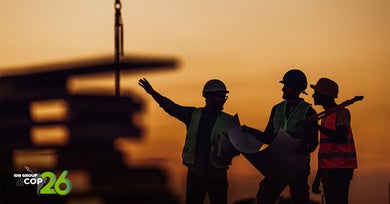
How a New Sustainable Mindset Will Help Future Construction
It’s important to invest in the construction of buildings that reduce greenhouse gas emissions, but it is equally, or more, important to create a new financial framework and a new mentality that helps investors direct their funds in this regard.

Rethinking the Digital Pathways of Latin America and the Caribbean
Latin America and the Caribbean need to renew their digital infrastructure if they aim to provide the quality of services that their users need. It’s time to improve the region’s connectivity landscape.

Better PPPs: Are today’s PPP models more sustainable?
There is a renewed interest for Public Private Partnerships (PPPs) in the water and sanitation (W&S) sector in the Latin American and Caribbean Region, proof being their increased number.

Solar energy: The revolution spurring development in Honduras
When Invema plant, the main plastic recycler in Honduras starts operating, a success formula resonates. It is one of the commercial companies that took advantage of the photovoltaic energy boom in the country. Its case demonstrates how the private sector’s investment in solar energy can facilitate greater economic and sustainable development for the country. Six years ago, the executives of the firm decided to install solar panels in the company, so it could generate its own power. This initiative promised a 20% reduction in energy consumption as well as a significant reduction in greenhouse gases emissions of polluting gases. And so it was. Today, Invema obtains energy savings up to 30% in electricity and reinvests in the focus of its business, recycling, so much so that it is now manufacturing the bottles that Coca-Cola uses in Central America. “We are very proud, because thanks to the solar panels, IDB Invest’s doors/channels opened up and allowed us to make the investments we dreamed,” says George Gatlin, the manager of Invema, which is located in the northern city of San Pedro Sula. Invema is part of many companies and private consortia that have opted for photovoltaic energy since Honduras decided to reform its electricity subsector to revert its electricity matrix from thermal to renewable. The reforms began in 2012, when generation using fossil fuels accounted for 70% compared to 30% for renewables. This thermal hegemony was reflected in increasing oil billing, carbon dioxide emissions, high tariffs up to US$0.30 per kilowatt (KW) produced, and frequent rationing. Following the reforms, led by the government with the advisory services of the Inter-American Development Bank (IDB), there was an upsurge in renewable energy until the energy matrix was completely reversed compared to 2012. The latest report from the Central Bank of Honduras (BCH) in 2018 records a 75% electricity generation based on renewable sources, and an 11% share of photovoltaic energy. This percentage translated into 433 megawatts (MW) of installed capacity at the end of 2016, placing Honduras in the lead of solar generation in Central America and third in Latin America, after Chile and Mexico. “We are witnessing a revolution in the electricity sector, not just in Honduras, but worldwide, because energy storage is changing the concept, points out Carlos Jácome, IDB energy specialist who has participated in the reforms process in Honduras. “The Bank support comprises studies and soft financing. Later, the savings make it possible to improve the productivity of these companies because they can use what they no longer pay in energy to expand their businesses,” comments Jácome. Since 2012, the IDB and IDB Invest have provided technical assistance to Honduran commercial, industrial, and institutional sectors to investigate the technical and financial feasibility of photovoltaic projects. To date, 22 studies have been completed for projects ranging from 40 kilowatts (kW) to nearly 3 MW of installed capacity. Official reports indicate that interest in photovoltaic projects have increased due to a reduction in about 40% of the installation costs over the last five years. Behind this innovation there are three combined components that have resulted in a successful formula: i) the impetus of government that created favorable conditions for investment; ii) the decisions made by entrepreneurial companies; and iii) the IDB’s ability to evaluate and finance the projects. The initial investments in photovoltaic development in Honduras involved a shared risk for IDB Invest and its clients. Nonetheless, what made the difference is the technical capabilities of the Bank for evaluating and support for this type of investments. The Honduran experience encourages entrepreneurship and new markets while demonstrating that IDB Invest is the partner of choice for innovative markets. Experiences of this kind should be replicated in the region. The first photovoltaic investments began in 2015, when 388 MW were installed, followed by 45 MV more in 2016, according to reports from the National Electrical Energy Company (ENEE). According to the ENEE, the Honduran commercial and industrial solar energy market is quite different from what it was in 2012, starting with changes in electricity billing (between 11 and 18 cents per kW per hour), installation costs for panels, legal regulations, and the availability of photovoltaic manpower in the region. In addition to this, national capacities have developed with the installation and administration of photovoltaic projects. “Before, if a Canadian, Spaniard or a Costa Rican person did not show up to supervise the project it didn’t move forward. Now the Hondurans themselves have been strengthening all these positions. There is a friendly environment for investment,” notes Elsia Paz, President of the Honduran Renewable Energy Association (EHER), one of the entities that emerged in the context of these reforms. Download the full story here: “Solar Energy: The Revolution Spurring Development in Honduras” Subscribe to receive more content like this! [mc4wp_form]

Brazil: Infrastructure Challenges and Opportunities
Within weeks of the Brazil Investment Forum, the development of the economy of South America’s colossus presents numerous challenges and opportunities. A major one is how to continue providing incentives for private sector investment in infrastructure to bridge the country’s funding gap. Synergies among development entities open up new and interesting opportunities for this market.

The Floods of 2017: How can the private sector mitigate the impact of natural disasters
There are many theories to explain the current trend of increasing frequency and magnitude of extreme events, but it seems obvious that there is a correlation with increasing average temperatures. Many argue that the world is already experiencing the consequences of climate change and that even if the increase on average world temperature is kept under 2 degrees Celsius, countries will have to adapt to a wider range of natural disasters. During 2017 the world witnessed the occurrence of severe floods from China to Canada. As we wrote this article, Italy was facing its second season of severe flooding. Latin America and the Caribbean was no exception, and Peru was particularly affected by this phenomenon. The floods in the Andean country destroyed 115,000 homes, leaving almost 180,000 homeless, over 110 people were killed, more than 350 were seriously injured, and over 2,500 kilometers of roads have been devastated. The region is particularly vulnerable to the occurrence of floods as it is the most impacted by El Niño. Additionally, due to its high urbanization rate, the impact of floods to cities and urban infrastructure are often devastating. While estimates of necessary annual investments to manage floods in the region vary, given the constraints on fiscal spending, the full burden of this cannot be met by governments alone. Therefore, the private sector has a key role to play, that involves both the development of software as well as hardware. Insurance: A key software for mitigation On the soft side, alternatives to avoid or mitigate the impact of severe floods include flood insurance, payment for environmental services, better flood assessment and warning systems, ecosystems planning, and zoning, among others. All these services can be provided by the private sector through the development of policies and adequate incentive frameworks. For example, unleashing private sector insurers to offer products in Latin America is no easy task but it can bring about a stream of benefits. Insurance is a fundamental component in any strategy of adaptation to natural disasters. As illustrated in a paper by the Global Facility Disaster Reduction and Recovery, flood insurance: Increases resilience against residual risks that cannot be prevented or mitigated Incentivize engagement and investment in risk mitigation measures Reduces pressure on the fiscal budget from natural disasters Private sector participation is driven by a complete shift toward risk-based rates, and more accurate mapping which in turn provide correct economic incentives both in urban as well as in rural areas (agriculture in particular). The private sector can apply innovation and technology to improve early warning systems. The earlier we can identify where storms are likely to hit, the better we can target efforts to minimize damages. In the Netherlands, for example, Siemens has created the concept of “smart levees” by implementing a monitoring system that uses sensors to gauge water pressure, temperature and shifting water profiles. This allows the identification of stretches of levees that are at higher risk of being breached. Innovative solutions for better hardware With respect to hardware, the most obvious opportunities relate to retrofitting and developing infrastructure that is more resilient, and can better perform under extreme conditions. The vulnerability of existing infrastructure was evident during the occurrence of natural disasters in 2017, and the private sector can bring capital, innovation, management systems, and technology. Following hurricane Maria devastation in Puerto Rico, Tesla’s Elon Musk, offered to green and revamp energy generation in the island through the installation of solar systems and high-tech batteries. Bold ideas and innovation will be necessary to assist Latin America and the Caribbean in adapting to the impacts of climate change. In doing so, a vital role of governments is to develop policies and regulatory frameworks that allow the creation of new business models and provide incentives for companies to invest on climate smart infrastructure. For instance, building and financing (public/private) business models for urban drainage transformation in megacities represents a gigantic opportunity to foster investments that will significantly improve the quality of life of millions of urban residents in the region. At IDB Invest we can draw lessons from our vast experience in the region that combined with disruptive technologies, and a menu of financing instruments can offer unique value propositions to our clients. We embrace the opportunity to work with private companies all over Latin America and the Caribbean in the development of innovative models that can contribute to better management of floods and other natural disasters in our countries. Subscribe to receive more content like this! [mc4wp_form]